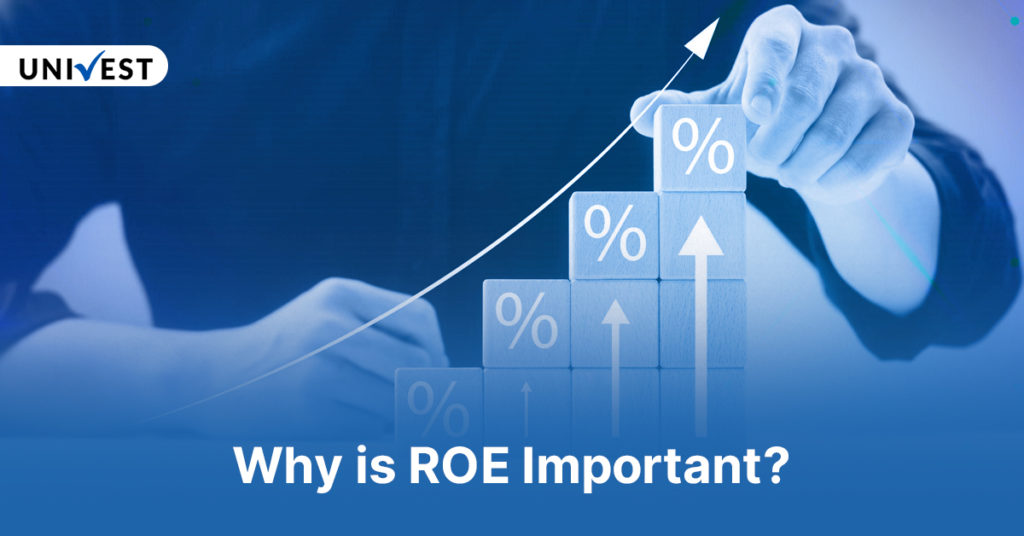
Return on Equity (ROE) – A Comprehensive Guide Towards Understanding ROE
Posted by : sachet | Tue Feb 18 2025

What is Return on Equity (ROE)?
Meaning: Return on Equity (ROE) is a profitability ratio that measures a company’s efficiency in generating profits relative to its equity capital. It tells investors how much net profit an organisation generates on each unit of shareholder’s equity.
This ratio is widely accepted because it connects two financial metrics of fundamental analysis: the profit and loss statement and the balance sheet.
Before we understand the Return on Equity ratio better, let us examine its two major aspects: Shareholder equity and net income.
Shareholder equity – It refers to a company’s net worth, which depicts the amount investors expect to receive in case of company liquidation. It is calculated by subtracting the debts from an organisation’s total assets.
Net Income – Net income or net earnings is the accurate measure of a business’s profitability. It is arrived at by deducting the business expenses such as cost of goods sold, selling and administrative expenses, depreciation, interest and taxes from the total revenue. Investors often refer to net income as a company’s bottom line.
The return on equity ratio is calculated by dividing the annual net income of a company by its shareholder equity. This financial ratio helps investors and other stock market participants to perform peer-to-peer comparisons of equity shares within the same industry.
ROE is a crucial metric for various stakeholders in the investing world. Analysts, traders and investors all use the return on equity ratio as a key financial indicator to assess the efficiency of a company’s management and operations. It helps them to analyse how much return is being generated by the corporation per unit of their shareholder’s equity.
Return on Equity (ROE) Formula and Calculation
The return on equity formula comprises the company’s net income and shareholder’s equity. The ROE formula for calculating the value of this ratio is as follows:
Return on equity formula = (Annual net income/shareholder’s equity)*100
Here,
Shareholder’s equity/Networth = Total Assets – Total Debts
Net Income = Total Revenue – Expenses (COGS, S&A expenses, depreciation, interest, amortisation and taxes)
The return on equity formula is easy to understand and calculate, leading to the wide acceptance of the ROE ratio as a key metric for investment analysis.
Calculation of Return on Equity (ROE) Ratio
Let us look at an example to understand how the return on equity ratio value is calculated. Suppose there is a company, X Tech Limited, which provides IT services to clients in India. Below are the financial metrics of the company for FY 2024.
| Particular | Value (₹) |
| Total Assets | ₹ 20,00,000 |
| Total Liabilities | ₹ 10,00,000 |
| Total Revenue | ₹ 20,00,000 |
| Expenses | ₹ 10,00,000 |
| Taxes | ₹ 5,00,000 |
Shareholders Equity = Total Assets – Total Liabilities
= ₹ 20,00,000 – ₹ 10,00,000
= ₹ 10,00,000
Net Income = (Total Revenue – Expenses) – Taxes
= (₹ 20,00,000 – ₹ 10,00,000) – ₹ 5,00,000
= ₹ 10,00,000 – 5,00,000
= ₹ 5,00,000
Return on Equity Formula = (Annual net income/shareholder’s equity)*100
= (₹ 5,00,000/₹ 10,00,000)*100
ROE = 5%

How do Return and Equity Works?
Typically, while analysing a listed or non-listed corporation, returns and equity (also known as stock or shares) are key metrics considered by investors all over the world.
Equity represents your ownership in a company in the form of stocks or shares. Since you park your hard-earned money to acquire these shares, you expect some return from your investments in these equities. This return can be earned in the form of dividends or by selling shares at higher prices than the price at which you bought them.
To understand your return profile on the equity shares that you hold, ratios such as return on equity come into play, which helps assess your rate of return. Thus, equities and returns go hand in hand studies extensively for making sound decisions in the stock market.
Interpretation of Return on Equity (ROE) Value
The interpretation of the return on equity value is subjective and can not be analysed on a standalone basis. ROE is a comparative tool used to compare various companies operating within the same industry. Moreover, if interpreted in isolation, it can provide misleading conclusions because it is calculated in percentage terms. For more clarity, have a look at the below possible interpretation of return on equity value:
High ROE Value – Usually, a high ROE indicates that the company is able to generate higher profits for each unit of equity capital. It tells investors that the company’s management is deploying and using the equity capital in the most efficient manner.
Low ROE Value – A low ROE value indicates a company’s inefficient performance. It shows that equity capital is not being utilised optimally, leading to a decrease in profits. A low return on equity tells investors that a business is offering a low return on its equity capital.
However, an important thing to note here is that the above interpretation of the return on equity (ROE) ratio is incomplete. This is because a higher ROE value can also mean that the equity capital has decreased, leading to a small denominator and inflated ROE. On the other hand, a lower ROE can also occur due to an increase in the equity capital over a period.
Therefore, investors must analyse a company’s ROE over a period of time and compare it with other businesses within the same industry to get a clear and decisive conclusion.

Benefits of Return On Equity (ROE)
Investors have used the return on equity (ROE) formula for a long time because of its varies set of uses. Some of the major benefits of ROE are:
Assessing company’s efficiency
As mentioned above it is the primary goal of the return on equity ratio to assess how efficiently a company is using its equity portion of total capital in the business. By looking at the ROE you can gauge how much return on each unit of shareholder’s equity is generating.
Analysing future growth
ROE helps in making good judgements about a company’s future growth rate by multiplying it by the retention rate. Retention rate is the portion of an organisation’s net profit which is retained in the business.
Identification of risk
An inflated or very high ROI helps in gauging the risk profile of a business. As mentioned above, a constantly rising ROE value can also occur due to lower shareholder equity, which can be the result of rising debt. Eventually, the increased amount of debt portion questions the financial stability of companies.
Assists in peer comparison
ROE is very useful in comparing various companies within the same industry or sector, which can further help in making the best investment decisions in equity markets.
Limitation of Return of Equity (ROE)
Even though it is one of the most sought-after profitability ratios, return on equity (ROE) also has certain limitations. The primary drawback of ROE is that it can not be used to analyse the companies which have negative income because there is no income. Moreover, a negative ROE can not be applied to compare business with a positive ROE value.
Secondly, comparing companies across different industries based on return on equity value is not possible because ROE is a subjective value depending on the dynamics of the respective industry.

Difference Between Return on Equity (ROE) and Return on Capital Employed (ROCE)
Return on Equity Ratio
- Return On Equity (ROE) tells how efficiently a company uses the equity portion of its total capital.
- It is calculated by dividing the net income by the shareholder’s equity.
- ROE is used in non-capital intensive industries.
Return on Capital Employed (ROCE)
- Return on Capital Employed (ROCE) represents the relationship between a company’s EBIT and total capital employed (debt + equity).
- It is calculated by dividing the EBIT by the total capital of the company.
- ROCE is used extensively in capital-intensive industries.
Conclusion
- Return on equity (ROE) ratio refers to the relationship between the net earnings and shareholder’s equity of a company. It measures the efficiency (in percentage) with which a corporation uses its equity in the business.
- It is extensively used by investors and other participants in the financial world to analyse their potential returns per unit of equity.
- While calculating the ROE value, the shareholder’s equity is derived by subtracting the liabilities from the assets. Whereas, the net income is calculated by subtracting expenses and taxes from total revenue.
- To optimise your investment research, you must use ROE in conjunction with other ratios and key performance indicators.
FAQ on Return on Equity (ROE)
1. What is the Return on Equity (ROE) ratio?
Return on Equity refers is a profitability ratio that provides insights into the return that investors can generate on their equity investments in a company. This ratio represents the relationship between the annual net income and equity portion of the total capital of a corporation.
2. What is a good ROE?
There is no fixed range of a good ROE in India because it differs from sector to sector. However, 15% – 20% is an acceptable range of ROE in India.
3. Should I invest in stocks using ROE value?
No, you should invest in stock only using ROE because it only provides insights about the efficiency of a company. Therefore, you must do in-depth research using other ratios and financial measures before investing in any stock. Some of the major parameters to use alone are the PE ratio, P/B ratio, D/E ratio, ROI, or dividend yield.
4. Which are the top 5 stocks in India with high ROE?
Top 5 stocks in India with ROE range between 20% – 30%
| Stock Name | LTP (₹) | Market Capitalisation (in cr.) | ROE (%) |
| Sharda Motors Industries Limited | ₹ 1,555 | ₹ 4,625 | 30.0 |
| Emami Limited | ₹ 541 | ₹ 23,601 | 30.0 % |
| G M Polyplast Limited | ₹ 115 | ₹ 155 | 24.8 % |
| Blue Dart Express Limited | ₹ 5,995 | ₹ 14,217 | 22.7 % |
| R R Kabel Limited | ₹ 1,112 | ₹ 12,569 | 20.8 % |
*Data updated as of 18th July 2025
Disclaimer: Investing in the stock market is subject to high volatility and potential riks. The securities mentioned above are just for informational purposes do not consider them as a recommendation for investing in the stock market. Please conduct your own thorough research before investing.
Read Our Articles on the Best Stocks
Railway Stocks in India to Invest in
Tobacco Stocks in India to Invest in
Best Tobacco Stocks in India 2025
Healthcare Stocks to Invest in India
Best Private Bank Stocks to Buy In India
Explore Current and Previous IPOs
| Company | Opening Date | Closing Date |
| Royalarac Electrodes Limited | 14th February 2025 | 18th February 2025 |
| Tejas Cargo Limited | 14th February 2025 | 18th February 2025 |
| Quality Power Electrics Equipment Limited | 14th February 2025 | 18th February 2025 |
| Shanmuga Hospital Limited | 13th February 2025 | 17th February 2025 |
| LK Mehta Polymers Limited | 13th February 2025 | 17th February 2025 |
| Voler Car Limited | 12the February 2025 | 14th February 2025 |
Univest Screeners
52-Week Low Stocks Today
| Stocks | LTP (₹) | New Low (₹) |
| VBL | ₹469.10 | ₹ 465.65 |
| JIOFIN | ₹ 221.02 | ₹ 217.01 |
| GODREJCP | ₹ 1015.55 | ₹ 1006.00 |
| IOB | ₹ 45.18 | ₹ 44.72 |
| CANBK | ₹ 84.65 | ₹ 83.52 |
| BHEL | ₹ 186.57 | ₹ 183.57 |
| COLPAL | ₹ 2450.00 | ₹ 2411.00 |
| IRCTC | ₹ 719.20 | ₹ 709.3 |
| PIIND | ₹ 3165.60 | ₹ 3097.60 |
| UCOBANK | ₹ 37.40 | ₹ 37.25 |
*Data is updated as of 17th February 2025.
52 Week High Stocks Today
| Stocks | LTP (₹) | New High (₹) |
| AARTIPHARM | ₹ 808.90 | ₹ 825.00 |
| MPSLTD | ₹ 2375.90 | ₹ 2877.30 |
| TCPLPACK | ₹ 3560.60 | ₹ 3911.60 |
*Data is updated as of 17th February 2025.

